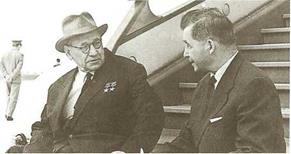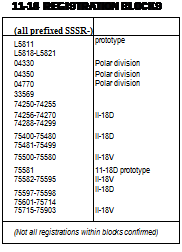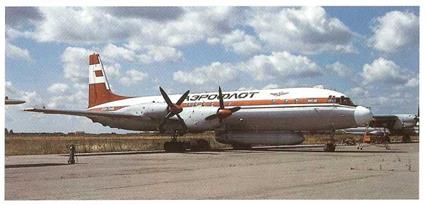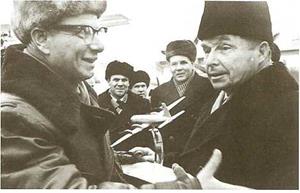Turboprop Workhorse


Ilyushin Keeps Pace
Believing that the turbopropeller solution to turbine-engined power was a good alternative to that of the pure jet, the British and American manufacturers had persevered with different designs. Following the successful four-engined (but only medium-range) Vickers Viscount of 1952, the Bristol company in England had developed the Britannia, a long-range four – engined airliner that, but for slow production and unforeseen engine problems, would have gone into service in 1956. Even so, by 1957, the Britannias were making their mark around the world. In the United States, Lockheed produced the Model 188 Electra, a smaller but efficient aircraft designed primarily for U. S. domestic inter-city routes, but not with full transcontinental range. Quickly brought into service early in 1959 — too quickly perhaps — the Electra had severe problems with the engine installation, and came close to being grounded because of fatal accidents soon after entering service.
Coinciding with the announcement of the Sixth Five-Year Plan, which once again emphasized the need to increase air travel on all fronts, Sergei Ilyushin and his team produced a Soviet four-engined turboprop which, as the table on the opposite page shows, fell in between the Britannia and the
This dramatic picture of an Ilyushin 11-18 was taken at Tiksi, on the Arctic coast of northern Siberia, in 1960, during the long polar night, as it was being serviced, (photo: Boris Vdovienko)
Two great aircraft designers, Andrei Tupolev (left) and Sergei Ilyushin (right) photographed informally in 1963. (Vdovienko)
Electra in performance and size. In outward appearance, all three aircraft looked somewhat similar.
Solid Performance
The Ilyushin 11-18 — at first called the Moskva — went into Aeroflot service on 20 April 1959, on the Moscow-Adler route, to provide needed extra capacity for Muskovite vacationers seeking the sun. Simultaneously, it started a non-stop route from Moscow to Alma Ata, the fast-growing capital of Kazakhstan. A direct Leningrad-Adler service, begun on 23 May, helped the citizens of Russia’s former capital to enjoy
the sun too; and on 20 June, the 11-18 reached Alma Ata by a circuitous route via Baku and Tashkent, the capitals of oil-rich Azerbaijan and Uzbekistan, respectively.
The PaSar Mainlisier
Reference has already been made to the expansion of Aeroflot’s horizons in 1960 by its taking over Aviaarktika (page 47), so that it could now study the potential for route expansion on a broad front north of the Trans-Siberian Railway. While Ilyushin had a set-back on 17 August of that year, when an 11-18 crashed near Kiev, another 11-18 made a proving flight on a new trans-Siberian route, by the great circle itinerary (as did also an Antonov An-10) and on 10 January 1961, opened regular service to Magadan, via the Arctic Sea port of Tiksi. Nine months later, another branch brought Anadyr, in remote Chukotka, within only eleven hours journey time of Moscow, eleven time zones away.
The Ilyushin 11-18 quickly established a reputation as a reliable, if not record-breaking airliner. It seemed to be at home in frigid climates of the northlands, and soon it was to experience an even more formidable challenge. For on 15 December 1961, it was selected to make the first flight by a commercial airliner to the Last Continent, Antarctica. For such a journey, extra tankage was provided, but later on, with growing maturity, a long-range version of the turboprop, the Ilyushin I1-18B, became almost standard equipment.
Mark Shevelev, the head of Polar Aviation, responsible for the pioneering development by air of vast areas of northern Russia, greets Sergei Ilyushin (right), one of the aircraft designers who made his work possible, (photo: Boris Vdovienko)
|
|

Ivchenko AI-20M (4×4, 250ehp) Ш MTOW 61,200kg (135,001b) Ш Normal Range 4,425km (2,750mi)
THREE LARGE FOUR-ENGINED TURBOPROPS COMPARED
|
||||||||||||||||||||||||||||||||||||||||||||
|
||||||||||||||||||||||||||||||||||||||||||||
 |
||||||||||||||||||||||||||||||||||||||||||||
|
||||||||||||||||||||||||||||||||||||||||||||
|
||||||||||||||||||||||||||||||||||||||||||||














